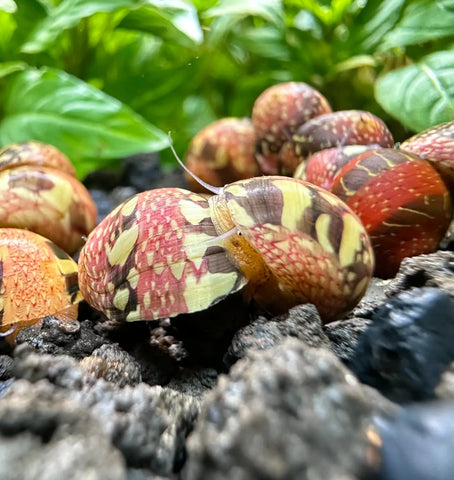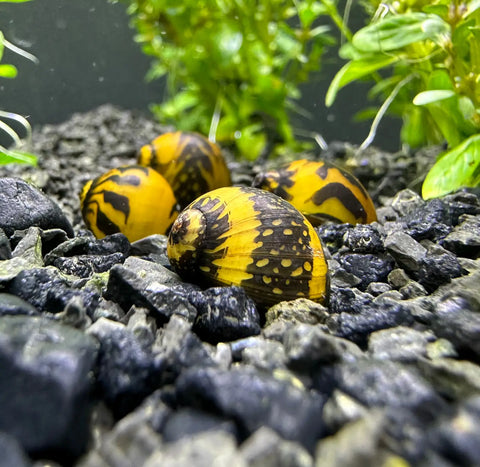Every aquarium owner eventually runs into the same problem: algae slowly taking over the tank. It may look harmless, but too much of it can turn a beautiful tank into a cloudy mess. Most beginners try scrubbing or chemicals, but the real solution lies in letting nature handle the job. Among all freshwater helpers, few work as effectively or safely as Nerite Snails.
These small, peaceful snails are famous for their ability to naturally clean tanks, eating various types of algae while remaining safe for plants and fish. In this guide, you’ll learn why Nerite Snails are considered the best algae cleaners, how they compare to other species, and how to care for them so your aquarium stays crystal clear.
Understanding the Algae Problem in Freshwater Aquariums
Algae is a sign of excess nutrients and an imbalance in your tank. But when it grows too fast, it blocks light, competes with plants for nutrients, and spoils the view. Overfeeding fish, intense lighting, or skipped water changes are usually the cause of this imbalance.
Manually wiping the glass works only for a few days. The smarter solution is to add natural algae eaters that maintain balance without disrupting the ecosystem. These creatures handle algae and debris the way they would in rivers and lakes, creating a balanced, low-maintenance ecosystem.
Excess algae signals a nutrient imbalance. Adding a natural cleaning crew like Nerite Snails helps restore stability.
What Makes Nerite Snails Such Effective Algae Eaters
Nerite snails are efficient cleaners because of their special mouth structure, a rasp-like tongue called a radula that scrapes algae from any surface, including glass, rocks, and driftwood. They work quietly, don’t disturb plants, and can even clean spots that brushes can’t reach.
Unlike many snails, Nerites don’t breed in freshwater, so that you won’t wake up to a tank full of baby snails. They’re also calm and non-aggressive, making them perfect for community aquariums.
Nerite Snails are among the few freshwater species that completely avoid damaging plants while controlling algae naturally.
These features make them ideal for hobbyists who want a clean, low-maintenance tank without harming aquatic plants or disrupting the setup.
Types of Nerite Snails and Their Cleaning Performance
Each Nerite species brings its own look and cleaning strengths. Choosing the right one depends on your tank size and the type of algae you deal with most.
|
Snail Type |
Appearance |
Algae Type Eaten |
Tank Size |
Special Traits |
|
Orange-black striped shell |
Soft film, glass algae |
10–40 gal |
Energetic cleaner with striking pattern |
|
|
Black and yellow spiral shell |
Hard algae on rocks |
5–30 gal |
Focused grazer, ideal for décor cleaning |
|
|
Compact with horn-like spikes |
Film and diatom algae |
5–15 gal |
Tiny yet effective in planted tanks |
The Tiger Nerite is perfect for larger setups needing heavy cleaning, while the Zebra Nerite suits smaller or decorative tanks.
Why Nerite Snails Outperform Other Algae Cleaners
Many aquarists compare Nerite Snails to other popular algae eaters, such as Mystery Snails, Amano Shrimp, and small Plecos. While each species has its role, Nerites offer the best balance between efficiency, safety, and ease of care.
Mystery Snails, for example, do a decent job with leftover food and soft algae, but they can reproduce rapidly and may nibble on delicate plants.
Amano Shrimp are excellent at removing hair algae, yet they’re sensitive to changes in temperature and water chemistry, making them harder to maintain long-term.
Plecos, though powerful cleaners, often grow too large for small tanks and produce more waste than most aquarists expect.
In contrast, Nerite Snails stay small, peaceful, and strictly focused on algae. They won’t harm plants, overcrowd the tank, or add heavy bioload. Their simple care routine and steady cleaning habits make them the most reliable, beginner-friendly choice for any freshwater setup.
Among freshwater algae eaters, Nerite Snails strike the perfect balance of control, safety, and sustainability.

How to Care for Nerite Snails for Lasting Results
Even though Nerite Snails are low-maintenance, they still need the right water conditions and setup to stay healthy and active. A few minor details make a big difference in how well they clean your tank.
Ideal Tank Conditions:
-
Temperature: Keep between 74–80°F for steady activity and shell health.
-
pH: Maintain a slightly alkaline range of 7.4–8.4 to protect their shells.
-
Hardness (GH): 8–18 dGH [moderate to hard] ensures enough calcium for shell strength.
-
Tank Size: Minimum of 5 gallons per snail, ideally with natural surfaces such as rocks or driftwood.
Feeding & Safety Tips:
-
Supplement with algae wafers or blanched spinach if algae levels drop.
-
Avoid copper-based medications or water treatments. Copper is toxic to snails.
-
Always acclimate them slowly when moving to a new tank to prevent temperature or pH shock.
A few Zebra or Tiger Nerites can keep a 20–40-gallon aquarium spotless with minimal maintenance.
Always acclimate Nerite Snails slowly to prevent stress or shock when introducing them to a new tank.
Creating a Balanced Cleanup Crew with Nerite Snails
A genuinely healthy aquarium has a team of cleaners working together. Pair Nerite Snails with Amano Shrimp or small Corydoras catfish; each handles different parts of the tank.
Keep about one snail for every 5 gallons. This gives enough coverage without crowding. Adding both Tiger and Zebra varieties ensures no surface is left untouched.
Explore the full range of live freshwater snails in the Nerite Snails Collection.

FAQs
Q1: Do Nerite Snails really remove all types of algae?
They effectively eat soft film, brown diatoms, and green-spot algae, but usually avoid thick hair or black beard algae.
Q2: Can Nerite Snails breed in freshwater tanks?
No, Nerite Snails cannot breed in freshwater because their eggs require brackish conditions to hatch, preventing overpopulation in home aquariums.
Q3: Are Nerite Snails safe for planted aquariums?
Yes, Nerite Snails are entirely plant-safe and help clean decaying leaves and surfaces without damaging healthy plants or disturbing delicate roots.
Q4: How many Nerite Snails should I keep in a 20-gallon tank?
Two to three Nerite Snails are ideal for steady algae control in a 20-gallon aquarium, maintaining cleanliness without overcrowding.
[Q5: How long do Nerite Snails live?
They typically live for 2-3 years with clean, stable water, adequate calcium levels, and a consistent supply of natural algae.
Conclusion
Nerite Snails are nature’s most reliable algae-cleaning crew. They work quietly, stay peaceful, and never harm plants or fish. Whether you choose the bold Tiger Nerite or the classic Zebra Nerite, you’ll enjoy a clearer, healthier, and more balanced aquarium.
They don’t need fancy setups, just clean water, stable parameters, and reasonable care. For aquarists who value natural beauty and effortless maintenance, Nerite Snails are simply the best algae cleaners you can find.
Ready to maintain a spotless aquarium naturally? Explore the Nerite Snails Collection at Aquatic Motiv, home to live freshwater snails shipped safely to your tank.

